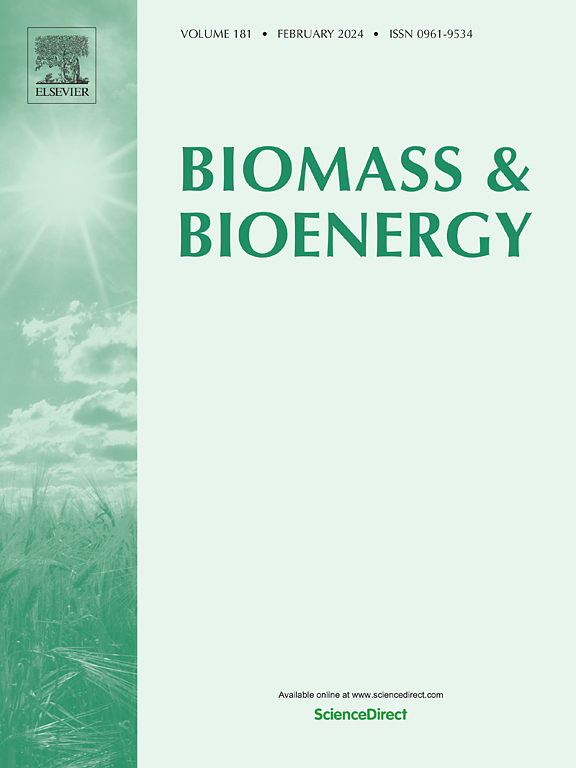Numerical investigation of reaction mechanisms on NOX emissions from biomass combustion with enhanced reduction
IF 5.8
2区 生物学
Q1 AGRICULTURAL ENGINEERING
引用次数: 0
Abstract
The present study examines the applicability of reaction kinetic mechanisms for predicting NOX emissions from biomass furnaces. These mechanisms are essential for numerical optimization of new innovative combustion technologies and therefore must be computationally affordable and provide reasonable accuracy in predicting NOX emissions. The selection of a suitable mechanism from literature is the goal of this work. The numerical investigations carried out utilized chemical reaction kinetic simulations with continuous stirred tank reactor networks. First, the predictions of a detailed benchmark mechanism are compared to experimental data and analyzed with regard to temperature, air-to-fuel equivalence ratio, residence time and producer gas composition. Then, various hybrid and reduced mechanisms are compared with the benchmark mechanism. The investigation showed a good agreement on the trends of NOX emissions from the detailed mechanism and measurements. The detailed mechanism can therefore be employed to find optimal operation windows in terms of temperature, air-to-fuel equivalence ratio and residence time. Benchmarking of the hybrid and reduced mechanisms showed large differences between the mechanisms. In conclusion, only one reduced mechanism is considered suitable for application in a full-scale 3D CFD simulation, which will be investigated in future studies.
生物质燃烧中氮氧化物排放的强化还原反应机理的数值研究
本研究探讨了预测生物质炉氮氧化物排放的反应动力学机制的适用性。这些机理对于新的创新燃烧技术的数值优化至关重要,因此必须在计算上负担得起,并在预测氮氧化物排放方面提供合理的准确性。从文献中选择合适的机制是这项工作的目标。所进行的数值研究利用了连续搅拌罐反应器网络的化学反应动力学模拟。首先,将详细基准机理的预测结果与实验数据进行比较,并对温度、空气与燃料当量比、停留时间和生产气体成分进行分析。然后,将各种混合和简化机制与基准机制进行比较。调查显示,详细机理与测量结果在氮氧化物排放趋势上有很好的一致性。因此,详细机制可用于寻找温度、空气与燃料等效比和停留时间方面的最佳运行窗口。混合机制和简化机制的基准测试表明,这两种机制之间存在很大差异。总之,只有一种简化机制适合应用于全尺寸三维 CFD 模拟,这将在今后的研究中进行探讨。
本文章由计算机程序翻译,如有差异,请以英文原文为准。
求助全文
约1分钟内获得全文
求助全文
来源期刊

Biomass & Bioenergy
工程技术-能源与燃料
CiteScore
11.50
自引率
3.30%
发文量
258
审稿时长
60 days
期刊介绍:
Biomass & Bioenergy is an international journal publishing original research papers and short communications, review articles and case studies on biological resources, chemical and biological processes, and biomass products for new renewable sources of energy and materials.
The scope of the journal extends to the environmental, management and economic aspects of biomass and bioenergy.
Key areas covered by the journal:
• Biomass: sources, energy crop production processes, genetic improvements, composition. Please note that research on these biomass subjects must be linked directly to bioenergy generation.
• Biological Residues: residues/rests from agricultural production, forestry and plantations (palm, sugar etc), processing industries, and municipal sources (MSW). Papers on the use of biomass residues through innovative processes/technological novelty and/or consideration of feedstock/system sustainability (or unsustainability) are welcomed. However waste treatment processes and pollution control or mitigation which are only tangentially related to bioenergy are not in the scope of the journal, as they are more suited to publications in the environmental arena. Papers that describe conventional waste streams (ie well described in existing literature) that do not empirically address ''new'' added value from the process are not suitable for submission to the journal.
• Bioenergy Processes: fermentations, thermochemical conversions, liquid and gaseous fuels, and petrochemical substitutes
• Bioenergy Utilization: direct combustion, gasification, electricity production, chemical processes, and by-product remediation
• Biomass and the Environment: carbon cycle, the net energy efficiency of bioenergy systems, assessment of sustainability, and biodiversity issues.
 求助内容:
求助内容: 应助结果提醒方式:
应助结果提醒方式:


